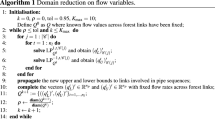Abstract
We are interested in the optimal control of sewage networks. It is of high public interest to minimize the overflow of sewage onto the streets and to the natural environment that may occur during periods of heavy rain. The assumption of linear flow in a discrete time setting has proven to be adequate for the practical control of larger systems. However, the possibility of overflow introduces a nonlinear and nondifferentiable element to the formulation, by means of a maximum of linear terms. This particular challenge can be addressed by smoothing methods that result in a nonlinear program (NLP) or by logical constraints that result in a mixed integer linear program (MILP). We discuss both approaches and present a novel tailored branch-and-bound algorithm that outperforms competing methods from the literature for a set of realistic rain scenarios.









Similar content being viewed by others
References
Bemporad A, Morari M (1999) Control of systems integrating logic, dynamics, and constraints. Automatica 35:407–427
Cembrano G, Figueras J, Quevedo J, Puig V, Salamero M, Martí J (2002) Global control of Barcelona sewerage system for environment protection. In: 15th IFAC world congress, vol R. Elsevier, Kidlington, pp 59–64
Cembrano G, Quevedo J, Salamero M, Puig V, Figueras J, Martí J (2004) Optimal control of urban drainage systems: a case study. Control Eng Pract 12(1):1–9
Chaudhry MH (2008) Open-channel flow. Springer, New York
Chow VT (1959) Open-channel hydraulics. McGraw-Hill, New York
Coron J-M, d’Andrea Novel B, Bastin G (1999) A Lyapunov approach to control irrigation canals modeled by saint-venant equations. In: European control conference
Coron J-M, d’Andrea Novel B, Bastin G (2007) A strict Lyapunov function for boundary control of hyperbolic systems of conservation laws. IEEE Trans Autom Control 52(1):2–11
CPLEX™ (2009) Version 12.1 (2009). IBM ILOG. Sunnyvale, California
Darsono S, Labadie J (2007) Neural-optimal control algorithm for real-time regulation of in-line storage in combined sewer systems. Environ Model Softw 22:1349–1361
de Halleux J, Prieur C, Coron J-M, d’Andréa Novel B, Bastin G (2003) Boundary feedback control in networks of open channels. Automatica 39(8):1365–1376
Diehl M (2002) Real-Time Optimization for Large Scale Nonlinear Processes, Fortschritt-Berichte VDI Reihe 8, Meß-, Steuerungs- und Regelungstechnik, vol 920. VDI Verlag
Forrest J, Tomlin J (2007) Branch and bound, integer, and non-integer programming. Ann Oper Res 149(1):81–87
Gelormino M, Ricker N (1994) Model-predictive control of a combined sewer system. Int J Control 59(3):793–816
Grossmann IE, Ruiz JP (2012) Generalized disjunctive programming: a framework for formulation and alternative algorithms for MINLP optimization. In: Lee J, Leyffer S (eds) Mixed integer nonlinear programming, the IMA volumes in mathematics and its applications, chap 4, vol 154, pp 93–116
Heemels W, Schutter BD, Bemporad A (2001) Equivalence of hybrid dynamical models. Automatica 37(7):1085–1091
Kirches C (2011) Fast numerical methods for mixed-integer nonlinear model-predictive control. Advances in numerical mathematics. Springer Vieweg
Kvasnica M, Grieder P, Baotić M (2004) Multi-Parametric Toolbox (MPT)
Leugering G, Schmidt J (2002) On the modelling and stabilization of flows in networks of open canals. SIAM J Control Optim 41(1):164–180
Litrico X, Fromion V (2009) Modelling and control of hydrosystems. Springer, London
Malaterre P-O, Baume J-P (1998) Modeling and regulation of irrigation canals: existing applications and ongoing researches. In: Systems, man, and cybernetics, IEEE international conference on 1998, vol 4. IEEE, pp 3850–3855
Marinaki M, Papageorgiou M (1998) Nonlinear optimal flow control for sewer networks. In: Proceedings of the American control conference, vol 2. Pennsylvania, Philadelphia, pp 1289–1293
Marinaki M, Papageorgiou M (2001) Rolling-horizon optimal control of sewer networks. In: Proceedings of the IEEE international conference on control applications. México City, México, pp 594–599
Marinaki M, Papageorgiou M (2005) Optimal real-time control of sewer networks. Springer, London
MATLAB™ (2008) Version 7.7.0 (R2008b). The MathWorks Inc. Natick, Massachusetts
Ocampo-Martinez C (2011) Model predictive control of wastewater systems. Advances in industrial control. Springer, London
Ocampo-Martinez C, Puig V (2010) Piece-wise linear functions-based model predictive control of large-scale sewage systems. IET Control Theory Appl 4(9):1581–1593
Pleau M, Colas H, Lavallée P, Pelletier G, Bonin R (2005) Global optimal real-time control of the Quebec urban drainage system. Environ Model Softw 20(4):401–413
Puig V, Cembrano G, Romera J, Quevedo J, Aznar B, Ramón G, Cabot J (2009) Predictive optimal control of sewer networks using CORAL tool: application to Riera Blanca catchment in Barcelona. Water Sci Technol 60(4):869–878
Rauch W, Bertrand-Krajewski J-L, Krebs P, Mark O, Schilling W, Schütze M, Vanrolleghem P (2002) Mathematical modelling of integrated urban drainage systems. Water Sci Technol 45(3):81–94
Schütze M, Butler D, Bruce Beck M (2002) Modelling, simulation and control of urban wastewater systems. Springer, London
Schütze M, Campisano A, Colas H, Schilling W, Vanrolleghem P (2004) Real time control of urban wastewater systems—where do we stand today? J Hydrol 299(3–4):335–348
Torrisi D, Bemporad A (2004) HYSDEL – a tool for generating computational hybrid models for analysis and synthesis problems. IEEE Trans Control Syst Technol 12(2):235–249
Williams H (1999) Model building in mathematical programming. Wiley, New York
Acknowledgments
This work has been partially funded by the EU Project EFFINET (FP7-ICT-2011-8-31855) and DGR of Generalitat de Catalunya (SAC group Ref. 2009/SGR/1491). Financial support of the Heidelberg Graduate School of Mathematical and Computational Methods for the Sciences and of the EU project EMBOCON under grant FP7-ICT-2009-4 248940 is gratefully acknowledged.
The cooperation of CLABSA (Claveguream de Barcelona S.A.) in providing data and useful guidance is also gratefully acknowledged.
Author information
Authors and Affiliations
Corresponding author
Rights and permissions
About this article
Cite this article
Joseph-Duran, B., Jung, M.N., Ocampo-Martinez, C. et al. Minimization of Sewage Network Overflow. Water Resour Manage 28, 41–63 (2014). https://doi.org/10.1007/s11269-013-0468-z
Received:
Accepted:
Published:
Issue Date:
DOI: https://doi.org/10.1007/s11269-013-0468-z




